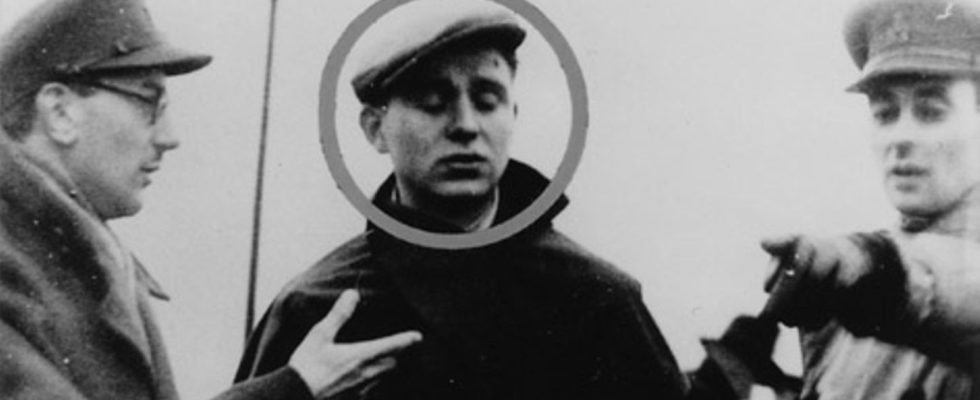Willie Herold
“Henker vom Emsland”: How an imposter became a mass murderer in World War II
Willi Herold (M.) was given the title “Henker vom Emsland” by historians
© absolutely media
Willi Herold was just a normal soldier – until he accidentally found a captain’s uniform. In it he mutated into a brutal murderer who terrorized an entire prison camp.
At the beginning of April 1945, the Second World War was already drawing to a close and the defeat of the German Reich could hardly be averted. Willi Herold, a 19-year-old private, had fought in Italy during the war and was then posted to Germany in the region bordering the Netherlands. There he lost his unit and wandered around alone. In the last few weeks of the war, Willi Herold began a new, horrible career that, although it only lasted a short time, cost many lives.
On the way, Herold unexpectedly came across an abandoned car by the side of the road – inside was a uniform with the insignia of a Luftwaffe captain. Herold exchanged his private uniform for her and seemed to take on a new personality at that moment. As Hauptmann Herold, he gathered more soldiers around him, led a brutal regiment and was responsible for the deaths of around 170 people within a few weeks.
Willi Herold – impostor in a captain’s uniform
A total of 80 soldiers joined Herold on his way through Emsland, members came and went from time to time, twelve belonged to the inner circle, the so-called “Herold Group”. Among them was a real sergeant who apparently had no idea that he was being commanded by someone far below him in rank. But Herold made up for his lack of experience with audacity, self-confidence and an extremely bossy demeanor. So he managed to fill the role of the captain credibly.
A few times the impostor almost got caught. But when he was checked, he always refused to show his non-existent papers, and he angrily rejected such requests. The checkpoints were always intimidated. So the group around Willi Herold came to Papenburg in Emsland on April 11, 1945, near the Dutch border. It was home to the Emsland camp Aschendorfermoor, a Nazi prison camp where prisoners were held for offenses such as undermining the armed forces or disobeying orders. The fake captain and his followers immediately took command.

Here, too, no one seriously questioned the legitimacy of Herold, who claimed that Hitler himself had given him direct command of the camp with unlimited powers. The uniform quickly silenced all doubts about the camp administration and the local NSDAP. “Domineering, decisive, not tolerating any arguments,” Herold said, prisoners remember. For Herold that was the license for a brutal series of murders.
Brutal murders in the Aschendorfermoor prison camp
He lined up the inmates in rows and shot them. He either carried out the executions himself or instructed his men to do so. In particular, he had prisoners who had attempted to escape and who were marked accordingly killed without any procedure. Before they died, the men selected for execution had to sing Hitler songs, dig their own graves, and then be shot at point-blank range or murdered with anti-aircraft guns and hand grenades. Herold and his soldiers are said to have killed more than 170 people in just eight days. “Not because they had to, but because they wanted to and enjoyed shooting people,” recalls a survivor in the documentary “The Captain of Muffrika,” which tells Herold’s story. The film received the Grimme Prize in 1998.
Not only the prisoners, but also the Nazi people had long since recognized Herold as a sadistic ruler. However, they couldn’t stop him. Only when Allied air raids reached the camp did Herold and his group flee the bombs. They moved on to the town of Leer, about 25 kilometers away, drank and celebrated, they hanged a farmer, and five Dutchmen were shot for alleged espionage.
“The Executioner from Emsland”: an example of German serfdom
On April 28, 25 days after he slipped into the uniform and role of captain, Willi Herold was arrested, but a high-ranking SS man obtained his release. Only on May 23, 1945, two weeks after Hitler’s death and the German capitulation, was he arrested again by the British – more or less by chance for theft. During interrogation, his crimes come to light. In August 1946, Herold and six other defendants were brought before the British military court. The public prosecutor at the time reports in “Der Hauptmann von Muffrika” about Herold: “My first impression was amazingly different from what I had expected.” The war criminal seemed “innocent, boyish, cheerful and awake” to him.
Herold has been given the name “The Executioner from Emsland” by historians, and his crimes in the prison camp are known as the “Massacre of Aschendorfermoor”. Herold’s exploits are a footnote in the history of World War II, but his short, brutal history is a powerful illustration of how easily uniforms and dashing demeanor could impress even senior military personnel in the realm. “People often sketched the grotesque that we would also greet a mailbox with our arms raised if we had been ordered to do so. We often laughed about it. We shouldn’t have done it,” a German journalist noted during the trial of Herold.
On November 14, 1946, Willi Herold was executed at the age of only 21 with a guillotine.
Sources: Movie “The Captain of Muffrika” (1998) / “Mirror” / “Hannoversche Allgemeine Zeitung”


